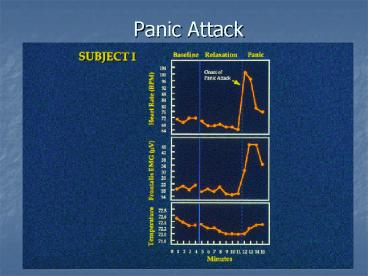Panic Attack - PowerPoint PPT Presentation
1 / 15
Title:
Panic Attack
Description:
Etiology of anxiety disorders involves fundamental emotional conditioning events ... Differential neurobiological bases of conscious vs unconscious conditioning ... – PowerPoint PPT presentation
Number of Views:319
Avg rating:3.0/5.0
Title: Panic Attack
1
Panic Attack
2
Interaction of Genes and Early Environment in
Producing Adult Major Depression
3
Discoveries from Behavioral Science
- Etiology of anxiety disorders involves
fundamental emotional conditioning events - Traumatic conditioning accounts incomplete
- Early panic attacks associated with interoceptive
and exteroceptive cues that trigger constellation
of behavioral and physiological responses
collectively called anxiety - These conditioning events influence performance
without conscious awareness1 - Differential neurobiological bases of conscious
vs unconscious conditioning processes now
apparent using brain imaging procedures2
1. LeDoux JE. The Emotional Brain The Mysterious
Underpinnings of Emotional Life 1996. 2. Bouton
ME, Mineka S, Barlow DH . Psychol Rev .
2001108(1)4-32.
4
The FutureTalking to the Amygdala
5
Therapy and the Amygdala
PFC-L (thought)
PFC-M (extinction)
Talk Therapy
Cognitive Behavioral Therapy
AMYGDALA
Drug Therapy (Valium/SSRI)
The absence of direct connections from the PFR-L
to the amygdala may be related to why talk
therapy for psychiatric conditions that involve
amygdala-related conditions is relatively
inefficient (in terms of the amount of time
required to achieve a therapeutic effect).
Behavioral therapy (including cognitive
behavioral therapy) is less dependent on
conscious insight and more dependent on
extinction processes and on the development of
new associations, skills, and habits (that is, on
implicit learning). Some of these processes
(especially extinction) involve the PFC-M. The
direction connection of the PFC-M with the
amygdala may explain why cognitive behavioral
therapy is more efficient for certain
fear/anxiety-related problems.
From LeDoux, J. (2002). Synaptic self How
our brains become who we are. New York Penguin
Books.
6
Perceptual processing vs. Cognitive evaluation
- Perceptual processing (match) of threatening
and fearful scenes was associated with a strong
bilateral amygdala response - Cognitive evaluation (label) of these same
stimuli was associated with an attenuation of
this response and a correlated increase in the
response of the right ventral PFC - From Hariri, A.R., Mattay, V.S., Tessitore, A.,
Fera, F., Weinberger, D.R. (2003). Neocortical
modulation of the amygdala reponse to fearful
stimuli. Biological Psychiatry, 53, 494501.
7
Cognitive-Behavioral Therapy, Imipramine, or
Their Combination for Panic Disorder A
Randomized Controlled Trial
NIMH Multicenter Collaborative Study
DH Barlow, Ph.D. Boston
Psychological Treatments JM Gorman, MD
Columbia Pharmacotherapy MK Shear, MD
Pittsburgh Psychological
Treatments SW Woods, MD Yale
Pharmacotherapy
Barlow DH et al. JAMA. 20002832529-2536.
8
Study Time Line
- Phases and Durations
Major assessments done at baseline,
post-acute, post-maintenance, and post follow-up
IMI/PLA subjects entered maintenance only if
they were responders at post-acute
assessment.Barlow DH et al. JAMA.
20002832529-2536.
9
Comparison of Baseline, Acute, and
MaintenanceTreatment for Intent-to-Treat (ITT)
Sample
N312
PDSS Average Item Score (0-4)
Treatment Condition
Barlow DH, et al. JAMA. 2000283(19)2529-2536.
10
Posttreatment Relapse Rate
N312
Relapsed Within 6 months
Based on Clinical Global Improvement Scale (CGI)
for intent-to-follow patients.
11
Comparison of Cognitive-BehavioralGroup
Treatment (CBGT) and phenelzine for social phobia
Plt.09 Plt.005 ?not assessed
Assessment
?
?
?
?
Posttreatment
Postmaintenance
6-Month Follow-Up
Statistical Comparisons
CBGT, PHEN gtPBO, ES
CBGTPHEN
CBGT?PHEN
PHENphenelzine. PBOpill placebo.
ESeducational-supportive group
treatment. Heimberg RG, et al. Arch Gen
Psychiatry. 199555(12)1133-1141. Liebowitz MR,
et al. Depress Anxiety. 199910(3)89-98.
12
Specific Psychological Treatments (PT) vs.
Medication or Alternative Treatments, all since
1998, from the Journal of the American Medical
Association or the New England Journal of Medicine
13
Specific Psychological Treatments (PT) vs.
Medication or Alternative Treatments, all since
1998, from the Journal of the American Medical
Association or the New England Journal of
Medicine, cont
14
Treatment of Depression, 1987-1997 National
Trends
- Context Increasing recognition and treatment of
depression - 1987 1997
- Percent treated by medications 37.3 74.5
- Percent treated by psychotherapy 71.1 60.2
- From Olfson, M. Marcus, S.C., Druss, B.,
Elinson, L., Tanielian, T., Pincus, H.A.
(2002). National trends in the outpatient
treatment of depression. Journal of the American
Medical Association, 287, 203-209.
15
Treatment of Depression, 1987-1997 National
Trends
- Context Increasing recognition and treatment of
depression - 1987 1997
- Percent treated by medications 37.3 74.5
- Percent treated by psychotherapy 71.1 60.2
- Percent treated by physician 68.9 87.3
- Percent treated by psychologist 29.8 19.1
- From Olfson, M. Marcus, S.C., Druss, B.,
Elinson, L., Tanielian, T., Pincus, H.A.
(2002). National trends in the outpatient
treatment of depression. Journal of the American
Medical Association, 287, 203-209.































